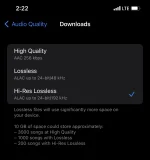Where did you find this information that
CarPlay is highly compressed? Apples documentation states you can use
CarPlay to listen to lossless audio.
I agree that
wireless CarPlay uses a wifi connection to steam from your phone to the audio device and is limited to CD quality audio (16bit/44.1kHz), but the GV70 does not have a
wireless CarPlay option unless a third party box is used. I have not seen where a wired connection using
CarPlay is limited to anything other than the audio format. I would also state that in a moving car with the background noise of driving and other traffic that music at 24bit/192kHz is indistinguishable from CD quality. Heck only on the highest of home systems that easily outperform the Lexicon system would I say I cold hear a difference between the two formats. I'd be shocked if the DAC in the Lexicon system and the speakers allow for an audible difference.
Again, I'm not saying wired
CarPlay isn't limited, but I haven't seen specs stating it is so I wanted to ask for references so I can read and learn more.
So here's the first issue: the vernacular apple is using is misleading and more marketing.
CarPlay is limited to 48khz/24bit.
In the world of audiophiles, most of us know about this stuff I am about to discuss. But there are more mainstream folks out there in the universe appropriating some audio terminology that may b...

audiophilereview.com
Apple's definition of lossless = 48/24 (whereas CD = 44/16).
And this is again a nomenclature issue (see article I posted above).
Most, if not all, modern recording masters are done at a minimum of 96/24 or 192/24 giving the label/artist the most flexibility in formats they can provide....
You can never turn a CD which is 44/16 to 96/24 because the bits are just not there to begin with.
Learn about lossless audio in Apple Music and how to turn it on or off for your device.

support.apple.com
I cannot locate the developer's presentation Apple gave to
CarPlay developers at this moment, but it's also confirmed there and where I originally got this information.
Apple does not support USB drive format like android does where the iPhone can just be a storage device.
It SEEMS that if you do not use
CarPlay when plugging in the iPhone to the car, it's just not recognized (at least prior to the most recent update).
The funny part is, you can download 192k/24b onto the phone - you just can't listen to anything above 48k/24b via
CarPlay no matter what you do, unless the device you connect to has it's own DSP and you are NOT using
CarPlay....
Apple's choices are sometimes odd and without logic.
There are many more links you can find to confirm this, but if I can find the original presentation, I will post it....
PS: There are some third party Music Players that claim to get around this limitation and support
CarPlay and I have noticed a few that actually display the bitrate on the phone and in the
CarPlay app as 96/24 or 192/24, however, I have no way of confirming they are actually showing the format playing, versus the format stored on the phone.... I've reached out to developers with no luck. I have used "Vox" on the App Store and IMHO, has the most reliable
CarPlay interface (still some weird glitches), but again - I cannot notice a difference, wired, versus the Apple MusicPlayer in the car.
PSS: Just because the phone outputs PCM, doesn't mean the bitrate being sent is higher than 48/24...
Developers have all the tools and information about the "reality" of what their apps do, and if they can bypass the typical
CarPlay limitation, but typical consumers don't....and believe me, I've tried.
My solution has been, and will remain, a USB memory stick which takes all the guesswork out of it.
And playing a REAL lossless audio file through the Lexicon (e.g., 96/24 or 192/24) actually makes a HUGE difference.
I had to change all my EQ settings when I gave up on
CarPlay - and even while driving, there is significantly more headroom (highs sound clearer, bass is more punchy).
No car environment is perfect and it's not a controlled environment because of variables like road noise, car speed, etc., but the best source material always provides the best sound regardless of environment (YMMV).









